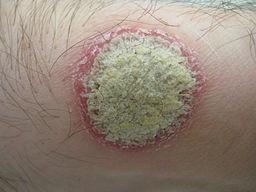Psoriatic Arthritis
How
Psoriatic Arthritis Affects the Knee.
Psoriatic arthritis
can affect joints all over your body, including your knees. This can cause your
knees to stiffen and swell, making it difficult to walk or bend. There is no
cure for psoriatic arthritis, but treatment can help manage the pain in your
knees and other symptoms. About 30% of people with psoriasis develop psoriatic
arthritis (PsA). Like rheumatoid arthritis, this form of chronic inflammatory
arthritis occurs when the body's immune system accidentally attacks its healthy
tissues. Although PsA only affects one joint in some people, it can affect any
joint in the body. For many people, the symptoms of psoriatic arthritis develop
in the knees, causing pain, swelling, and stiffness in the joints.
Psoriatic arthritis is a common form of arthritis that affects both the joints and the skin.
Prognosis.
Psoriatic arthritis is usually a mild condition. With proper treatment and the help of others, you can relieve joint pain and stiffness and control skin problems. However, some people have a more serious illness and need a combination of medications to control the symptoms and prevent joint damage.
Incident.
About 10% of people
whose skin condition is known as psoriasis will develop an associated
inflammatory arthritis. Inflammatory forms of arthritis are those that cause
prolonged stiffness with joint swelling and pain at night and in the morning
and usually improve with activity.
Psoriatic arthritis affects approximately 300,000 people in the United States.
It affects men and women of all races. It usually occurs between the ages of 20
and 30, but can occur at any age. It affects about five to eight percent of
people who have psoriasis.
Symptoms.
Common symptoms of
psoriasis and psoriatic arthritis include:
- Pain and swelling in one or more joints, usually in the last joints of the fingers or toes, wrists, knees or ankles. In some people with psoriatic arthritis, only one joint may be affected, while in others it resembles rheumatoid arthritis. The sacroiliac joint and spinal cord may also be involved. Because of this, psoriatic arthritis belongs to a group of disorders called spondylo arthropathy (spondylo = spinal cord; arthropathy = joint disease).
- Rough red spots that may appear on the scalp, elbows, knees, and / or lower extremities of the spine (often psoriasis may be just a small spot on the scalp. In some people the rash may cover a large area of the body).
- Swelling of the fingers and / or toes which makes them look like "sausage".
- Rheumatoid arthritis can develop over a long period of time or it can appear suddenly. Psoriasis usually develops months to years before the swelling and pain in the joints.
Peripheral arthritis is a form of arthritis that affects large joints, including the knees, elbows, wrists and ankles. Peripheral arthritis is more common in people with PSA, according to the Arthritis Foundation. Peripheral arthritis can cause discomfort that spreads from one joint to another, and if left untreated can cause pain from a few days to several weeks.
Diagnosis.
Because the symptoms of this type of arthritis are similar to other forms of arthritis, such as gout and rheumatoid arthritis, the doctor may perform some or all of the following tests:
- Combined fluid tests to rule out another rheumatic disease that may be similar to psoriatic arthritis. In most people with psoriatic joint fluid contains many inflammatory cells and although the absence of uric acid crystals can rule out gout, many other inflammatory forms of joint pain have the same number of white blood cells in the fluid. Is. The knee joint is the simplest joint from which fluid can be obtained for analysis and can only be removed by inserting a needle into the joint (this procedure is called arthrosynthesis) if the joint is swollen.
- X-rays to see changes in your bones and joints X-rays to see changes in your bones and joints.
- Blood tests to rule out other diseases such as rheumatoid arthritis and to document the presence of inflammation.
Treatment.
Treatment for
rheumatoid arthritis depends on how serious your condition is and which parts
of the body are affected. Treatment goals are to reduce joint pain and
swelling, control skin blemishes, and slow down or prevent joint damage.
Treatment may include one or a combination of skin care medications and other
treatments.
Self-management.
Take good care of
your skin, especially in winter. This can help reduce dryness and skin lesions
caused
by psoriasis. Prevent your skin from becoming dry by following these
tips:
- Use lotion or lanolin cream.
- Use non-deodorant soap.
- Put baby oil in your bath water or rub it on your skin after bathing.
- Use a humidifier in the winter.
- Avoid using strong soaps or chemicals.





Comments
Post a Comment